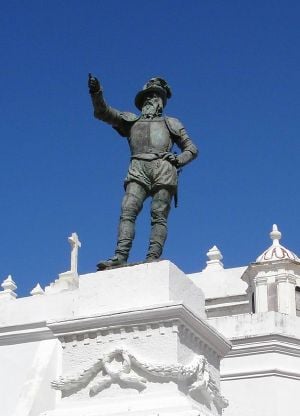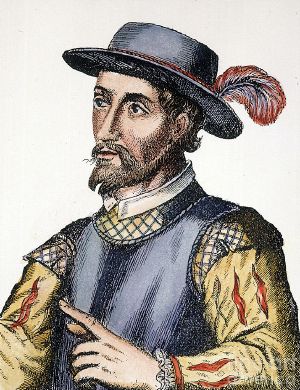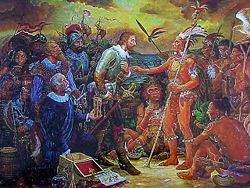Difference between revisions of "Juan Ponce de León" - New World Encyclopedia
(→Legacy) |
|||
| Line 6: | Line 6: | ||
==Arrival in the New World== | ==Arrival in the New World== | ||
| − | [[Image:Agueybana.JPG|right|thumb| | + | [[Image:Agueybana.JPG|right|thumb|250px|Chief [[Agueybana]] greeting Ponce de León]] |
| − | + | Although evidence is uncertain, it is believed that Ponce de León first landed near present-day [[Cockburn Town]] on [[Grand Turk Island|Grand Turk]] in the in the West Indies but soon settled in [[Hispaniola]]. He helped conquer the indigenous [[Taino]]s of the eastern part of Hispaniola and was rewarded with the governorship of the newly created Province of Higuey. While there, he was attracted by stories of the wealth of ''Borinquen'' (now [[Puerto Rico]]), and received permission to go there. | |
| − | In 1508, Ponce de León founded the first settlement in Puerto Rico | + | In 1508, Ponce de León founded the village of Caparra, the first settlement in Puerto Rico. He was greeted with open arms by the Taino chief [[Agüeybaná]] and quickly gained control of the island. As a result, Ponce de León was named Governor of Puerto Rico in 1509. He and the other [[conquistador]]s forced the Tainos to work in the mines and to construct fortifications. The Tainos died in great numbers after exposure to the European diseases that the sailors brought with them, to which they had no immunity. |
| − | + | Ponce de León became wealthy while serving as Governor. He married a Spanish woman named Leonore and had two daughters and one son. | |
| − | |||
| − | |||
| − | + | In the meantime, however, Chrisopher Columbus' son, Diego, had taken his own claim to the governorship of Puerto Rico--denied to him in 1506 upon Columbus' death—to the highest court in [[Madrid]] and won his rights. As a result, Ponce de León was removed from office in 1511. Feeling that his good name had been damaged and not wishing to serve Diego, Ponce de León obtained official permission to explore the areas north of [[Cuba]] instead. | |
| − | |||
[[Image:Juan Ponce de Leon statue.jpg|thumb|left|Statue of Juan Ponce de León at the Plaza San José in [[San Juan, Puerto Rico]]. The statue was made in [[New York]] in 1882 using the bronze from English cannons seized after the English attacked San Juan in 1792.]] | [[Image:Juan Ponce de Leon statue.jpg|thumb|left|Statue of Juan Ponce de León at the Plaza San José in [[San Juan, Puerto Rico]]. The statue was made in [[New York]] in 1882 using the bronze from English cannons seized after the English attacked San Juan in 1792.]] | ||
==First voyage and discovery of Florida== | ==First voyage and discovery of Florida== | ||
| − | Ponce de León equipped three ships at his own expense, and set out on his voyage of discovery and conquest in 1513. On March 27 | + | Ponce de León equipped three ships at his own expense, and set out on his voyage of discovery and conquest in 1513. He had reportedly learned from local inhabitants of an island called Bimini which contained a miraculous spring that restored youthful vigor to those who drank from it. On March 27 of that year he sighted an [[island]], but sailed on without landing. On April 2, he landed somewhere on the northeast coast of Florida, claiming the land for Spain. He named it ''La Florida'', meaning ''flowered'', both because of its lush vegetation and the fact that it was the Easter season—''Pascua Florida'' in Spanish. |
| − | Ponce de León then sailed south along the Florida coast, charting the rivers he found | + | Ponce de León then sailed south along the Florida coast, charting the rivers he found. He passed around the [[Florida Keys]] and up the west coast of of the peninsula to [[Cape Romano]]. He then sailed back south to [[Havana]] and then up to Florida again, stopping at the Bay of ''Chequesta'' ([[Biscayne Bay]]) before returning to Puerto Rico. |
Ponce de León may not have been the first European to reach Florida. He encountered at least one [[Native Americans in the United States|Native American]] in Florida in 1513 who could speak [[Spanish language|Spanish]]<ref>Smith, Hale G. and Marc Gottlob. 1978. Spanish-Indian Relationships: Synoptic History and Archaeological Evidence, 1500-1763, in [[Jerald T. Milanich|Milanich, Jerald]] and Samuel Proctor. ''Tacachale: Essays on the Indians of Florida and Southeastern Georgia during the Historic Period.'' Gainesville, Florida: The University Presses of Florida. ISBN 0-8130-0535-3</ref>. [[Image:poncedeleonburial.jpg|thumb|Cathedral where Ponce de León is buried|200px|right|Ponce de León's resting place]] | Ponce de León may not have been the first European to reach Florida. He encountered at least one [[Native Americans in the United States|Native American]] in Florida in 1513 who could speak [[Spanish language|Spanish]]<ref>Smith, Hale G. and Marc Gottlob. 1978. Spanish-Indian Relationships: Synoptic History and Archaeological Evidence, 1500-1763, in [[Jerald T. Milanich|Milanich, Jerald]] and Samuel Proctor. ''Tacachale: Essays on the Indians of Florida and Southeastern Georgia during the Historic Period.'' Gainesville, Florida: The University Presses of Florida. ISBN 0-8130-0535-3</ref>. [[Image:poncedeleonburial.jpg|thumb|Cathedral where Ponce de León is buried|200px|right|Ponce de León's resting place]] | ||
| − | + | In 1514 Ponce de León returned to Spain and received commissions to conquer the native [[Carib]]s of [[Guadalupe]] and to colonize what he still believed to be the ''Island of Florida''. His expedition to Guadalupe in 1515 was not successful, and he returned to Puerto Rico where he stayed until 1521. | |
| − | In 1514 Ponce de León returned to Spain and received commissions to conquer the [[Carib]]s of [[Guadalupe]] and to colonize the ''Island of Florida''. His expedition to Guadalupe in 1515 was not successful, and he returned to Puerto Rico where he stayed until 1521. | ||
| − | + | Ponce de León then organized a colonizing expedition to Florida on two ships. It consisted of some 200 men, including [[priest]]s, farmers, and artisans, 50 horses, and other domestic animals, and farming implements. The expedition landed on the southwest coast of Florida, somewhere in the vicinity of the [[Caloosahatchee River]] or [[Charlotte Harbor (estuary)|Charlotte Harbor]]. The colonists were soon attacked by native [[Calusa]]s and Ponce de León was injured by a poisoned arrow to the shoulder. After this attack, he and colonists sailed to [[Havana]], [[Cuba]], where he soon died of the wound. His tomb is in the cathedral in [[Old San Juan]]. | |
| − | |||
==Legacy== | ==Legacy== | ||
Revision as of 19:58, 21 August 2007
Juan Ponce de León (c. 1460 – July 1521) was a Spanish conquistador. He was born in Santervás de Campos (Valladolid). As a young man he joined the war to conquer Granada, the last Moorish state on the Iberian peninsula. Ponce de León accompanied Christopher Columbus on his second voyage to the New World. He became the first Governor of Puerto Rico by appointment of the Spanish Crown. He is also notable for his voyage to Florida, the first known European excursion there, as well as for being associated with the legend of the Fountain of Youth.
Arrival in the New World
Although evidence is uncertain, it is believed that Ponce de León first landed near present-day Cockburn Town on Grand Turk in the in the West Indies but soon settled in Hispaniola. He helped conquer the indigenous Tainos of the eastern part of Hispaniola and was rewarded with the governorship of the newly created Province of Higuey. While there, he was attracted by stories of the wealth of Borinquen (now Puerto Rico), and received permission to go there.
In 1508, Ponce de León founded the village of Caparra, the first settlement in Puerto Rico. He was greeted with open arms by the Taino chief Agüeybaná and quickly gained control of the island. As a result, Ponce de León was named Governor of Puerto Rico in 1509. He and the other conquistadors forced the Tainos to work in the mines and to construct fortifications. The Tainos died in great numbers after exposure to the European diseases that the sailors brought with them, to which they had no immunity.
Ponce de León became wealthy while serving as Governor. He married a Spanish woman named Leonore and had two daughters and one son.
In the meantime, however, Chrisopher Columbus' son, Diego, had taken his own claim to the governorship of Puerto Rico—denied to him in 1506 upon Columbus' death—to the highest court in Madrid and won his rights. As a result, Ponce de León was removed from office in 1511. Feeling that his good name had been damaged and not wishing to serve Diego, Ponce de León obtained official permission to explore the areas north of Cuba instead.

First voyage and discovery of Florida
Ponce de León equipped three ships at his own expense, and set out on his voyage of discovery and conquest in 1513. He had reportedly learned from local inhabitants of an island called Bimini which contained a miraculous spring that restored youthful vigor to those who drank from it. On March 27 of that year he sighted an island, but sailed on without landing. On April 2, he landed somewhere on the northeast coast of Florida, claiming the land for Spain. He named it La Florida, meaning flowered, both because of its lush vegetation and the fact that it was the Easter season—Pascua Florida in Spanish.
Ponce de León then sailed south along the Florida coast, charting the rivers he found. He passed around the Florida Keys and up the west coast of of the peninsula to Cape Romano. He then sailed back south to Havana and then up to Florida again, stopping at the Bay of Chequesta (Biscayne Bay) before returning to Puerto Rico.
Ponce de León may not have been the first European to reach Florida. He encountered at least one Native American in Florida in 1513 who could speak Spanish[1].
In 1514 Ponce de León returned to Spain and received commissions to conquer the native Caribs of Guadalupe and to colonize what he still believed to be the Island of Florida. His expedition to Guadalupe in 1515 was not successful, and he returned to Puerto Rico where he stayed until 1521.
Ponce de León then organized a colonizing expedition to Florida on two ships. It consisted of some 200 men, including priests, farmers, and artisans, 50 horses, and other domestic animals, and farming implements. The expedition landed on the southwest coast of Florida, somewhere in the vicinity of the Caloosahatchee River or Charlotte Harbor. The colonists were soon attacked by native Calusas and Ponce de León was injured by a poisoned arrow to the shoulder. After this attack, he and colonists sailed to Havana, Cuba, where he soon died of the wound. His tomb is in the cathedral in Old San Juan.
Legacy
Ponce de León's claim to fame is the discovery of Florida in 1513 and the Gulf Stream, and he was the first European to establish a colony in what is now known as Puerto Rico, serving as its first governor. He also searched for the legendary Fountain of Youth, which has entered the Ameican annals of lore and legend.
The Taino and the Calusa Indians who were living in Florida at the time were overcome by the Spanish, not only in attacks, but also by the spread of measles, influenza, and smallpox for which the native had no immunity, so Ponce de Leon also left a legacy of death and destruction among the native population.
Today, Ponce de León’s legacy is evident in Puerto Rico, where Spanish is still the official language and Roman Catholicism, brought to the island by the Spanish, is the main religion. Even though the Taino have died out, their inventions of hammocks and barbecues are used worldwide.
Notes
- ↑ Smith, Hale G. and Marc Gottlob. 1978. Spanish-Indian Relationships: Synoptic History and Archaeological Evidence, 1500-1763, in Milanich, Jerald and Samuel Proctor. Tacachale: Essays on the Indians of Florida and Southeastern Georgia during the Historic Period. Gainesville, Florida: The University Presses of Florida. ISBN 0-8130-0535-3
ReferencesISBN links support NWE through referral fees
- Thompson, William, & Thompson, Dorcas. The Spanish Exploration of Florida, Mason Crest Publishers, 2002. ISBN 978-1590840535
- Fuson, Robert H. Juan Ponce de Leon and the Spanish Discovery of Puerto Rico and Florida, McDonald and Woodward Publishing Company, 2000. ISBN 978-0939923847
- Peck, Douglas T. Ponce de Leon and the Discovery of Florida: The Man, the Myth, and the Truth, Pogo Press, 1993. ISBN 978-1880654026
- Lawson, Edward W. The Discovery of Florida and Its Discoverer Juan Ponce de Leon, Kessinger Publishing, 2007. ISBN 978-1432561246
- Green, Tamara. Juan Ponce de Leon, Gareth Stevens Publishing, 2001. ISBN 978-0836851786
Credits
New World Encyclopedia writers and editors rewrote and completed the Wikipedia article in accordance with New World Encyclopedia standards. This article abides by terms of the Creative Commons CC-by-sa 3.0 License (CC-by-sa), which may be used and disseminated with proper attribution. Credit is due under the terms of this license that can reference both the New World Encyclopedia contributors and the selfless volunteer contributors of the Wikimedia Foundation. To cite this article click here for a list of acceptable citing formats.The history of earlier contributions by wikipedians is accessible to researchers here:
The history of this article since it was imported to New World Encyclopedia:
Note: Some restrictions may apply to use of individual images which are separately licensed.


